
Haworthia is a large genus of small succulent plants endemic to Southern Africa (Mozambique, Namibia, Lesotho, Eswatini and South Africa).

Gasteria is a genus of succulent plants, native to South Africa and the far south-west corner of Namibia.

Haworthia cymbiformis is a species of the genus Haworthia in the family Asphodelaceae, endemic to the Eastern Cape Province in South Africa.

Haworthiopsis coarctata, formerly Haworthia coarctata, is a species of flowering succulent plant from the Eastern Cape Province, South Africa and naturalized in Mexico. It is one of the species of Haworthiopsis that is commonly cultivated as an ornamental.

Haworthia truncata, locally known as horse's teeth, is a species of succulent plant in the genus Haworthia. It is found in the Little Karoo region, in the far east of the Western Cape Province, South Africa.

Haworthia magnifica is a species of the genus Haworthia belonging to the family Asphodelaceae.

Haworthia mirabilis is a species of the genus Haworthia belonging to the family Asphodelaceae.
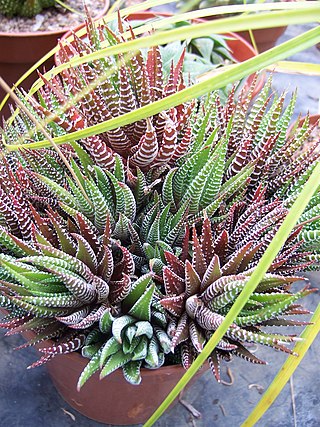
Haworthiopsis attenuata, formerly Haworthia attenuata, commonly known as zebra haworthia, is a small species of succulent plant from the Eastern Cape Province, South Africa. As an ornamental, it is one of the most commonly cultivated of the Haworthiopsis species.

Tulista is a small genus of succulent plants endemic to the Cape Provinces of South Africa. They were formerly included within the genus Haworthia.

Haworthia cooperi is a diverse and varied species of the genus Haworthia in the family Asphodelaceae, endemic to the Eastern Cape Province in South Africa.
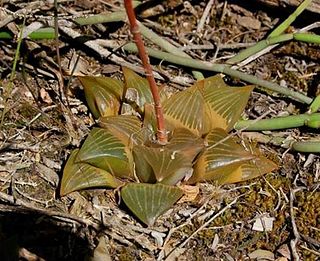
Haworthia retusa is a species of flowering plants of the genus Haworthia in the family Asphodelaceae, endemic to a very small area around Riversdale, in the Western Cape Province in South Africa. Growing to 10 cm (3.9 in) tall and broad, it is a perennial succulent with thick triangular leaves and small white tubular flowers held in 50 cm (20 in) tall racemes.

Haworthiopsis nigra, formerly Haworthia nigra, is a species of flowering succulent plant from the Western and Eastern Cape Provinces, South Africa.

Gasteria carinata is a small and variable succulent plant, native to the Western Cape Province, South Africa.
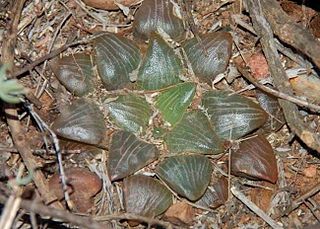
Haworthia bayeri is a species of the genus Haworthia in the family Asphodelaceae, endemic to the southern Cape Provinces in South Africa.

Haworthiopsis scabra, formerly Haworthia scabra, is a species of flowering succulent plant from arid regions of the Western and Eastern Cape Provinces, South Africa.
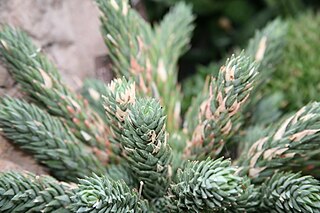
Haworthiopsis glauca, formerly Haworthia glauca, is a species of flowering succulent plant from the Eastern Cape Province, South Africa.

Haworthiopsis viscosa, formerly Haworthia viscosa, is a species of flowering succulent plant from the Western and Eastern Cape Provinces, South Africa.
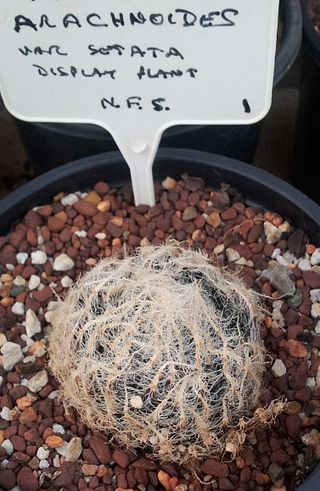
Haworthia arachnoidea, locally known as "papierrosie" (paper-rose) or "spinnekopnes" (spider-nest), is the type species of the genus Haworthia, in the family Asphodelaceae, in the Western Cape Province of South Africa.
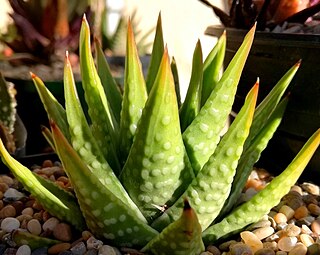
Tulista kingiana is a species of succulent plant, from the Western Cape, South Africa. It is listed as Endangered on the IUCN global Red List.

Aloeae is a tribe of succulent plants in the subfamily Asphodeloideae of the family Asphodelaceae, consisting of the aloes and their close relatives. The taxon may also be treated as the subfamily Alooideae by those botanists who retain the narrower circumscription of Asphodelaceae adopted prior to the APG III system. Typically, plants have rosettes of more or less succulent leaves, with or without a distinct stem. Their flowers are arranged in racemes and tend to be either small and pale, pollinated by insects, or larger and more brightly coloured, pollinated by birds. As of 2017, 11 genera are recognized, most created since 2010 by splitting off another five genera from Aloe and another two from Haworthia. Only two genera, Aloe and Aloidendron, are native outside southern Africa, extending northwards to the Arabian Peninsula. Seven genera are restricted to South Africa, some with small ranges. Members of the Aloeae are cultivated by succulent plant enthusiasts; Aloe species especially are used in temperate climates as ornamental garden plants. Some species are used in traditional medicine. Aloe vera and Aloe ferox are cultivated for their extracts, whose uses include moisturizers and emollients in cosmetics.




















